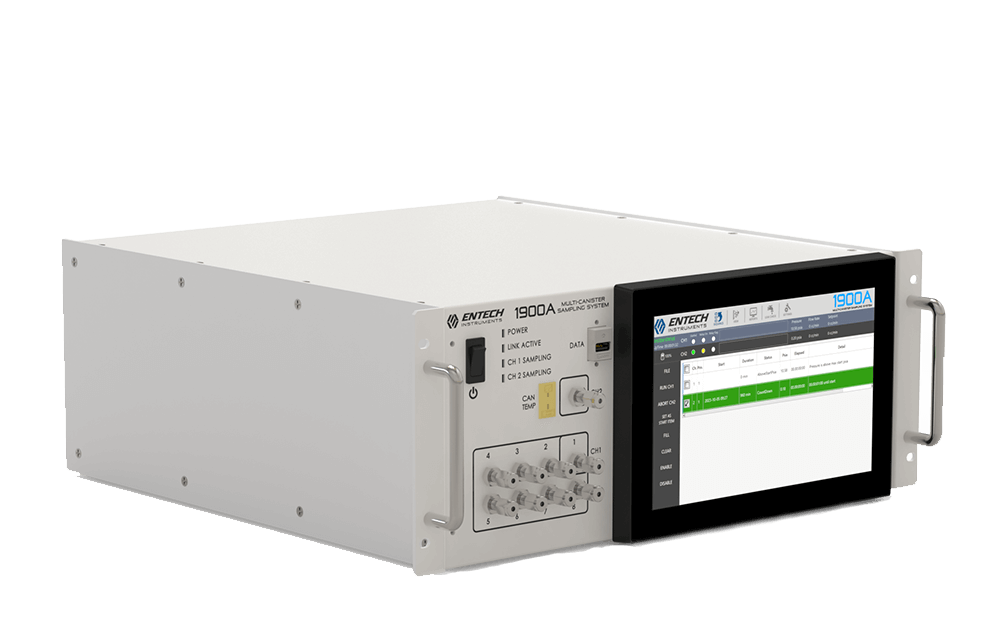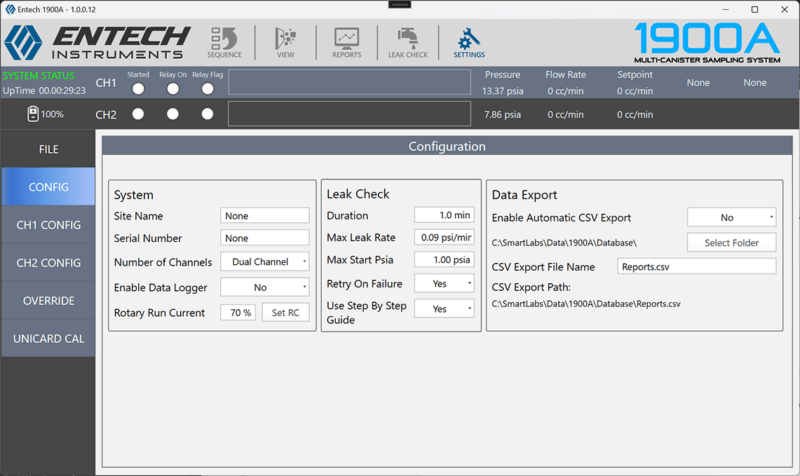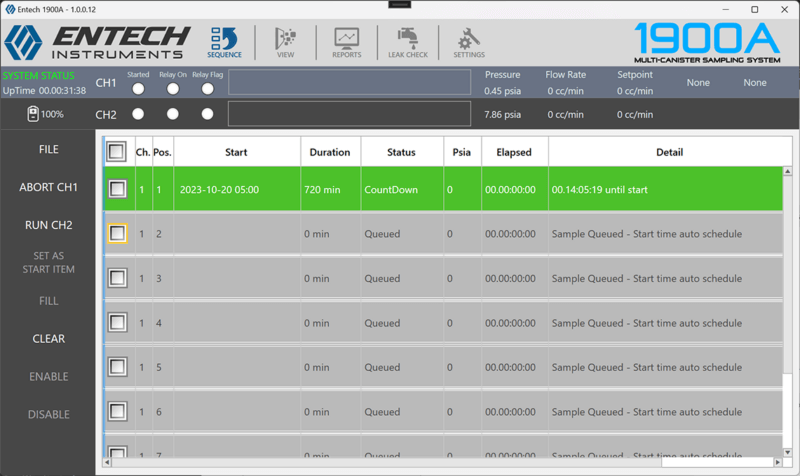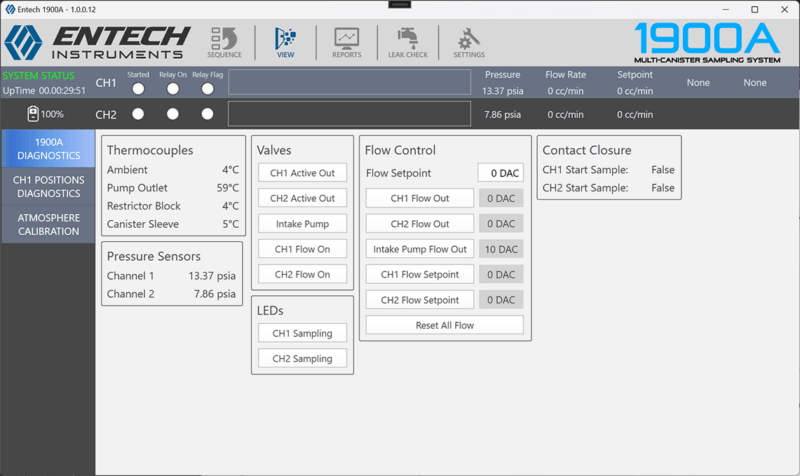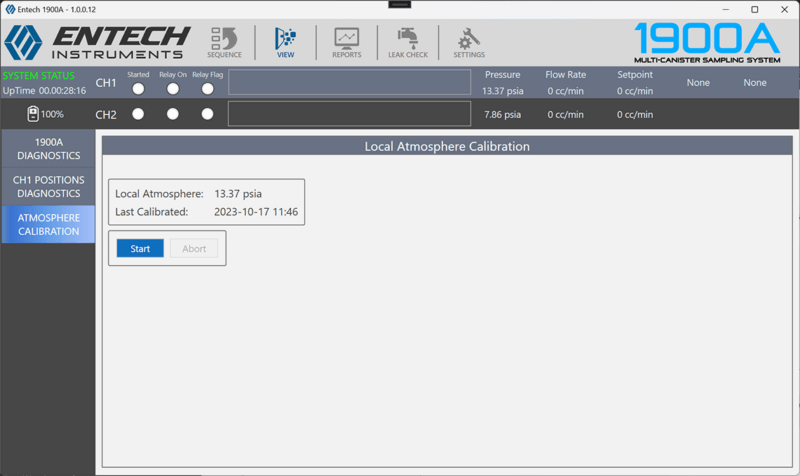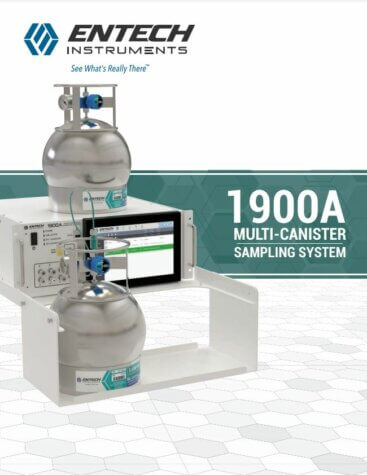1900A Multi-Canister Sampling System
Next Generation Canister Sampler
Introducing the 1900A Dual Channel Canister Sampler – the ultimate solution for accurate and reliable remote air sampling. The 1900A’s 3rd generation design has been engineered to meet the most stringent requirements of environmental monitoring, meeting or exceeding the requirements of US EPA Method TO15A. The 1900A dramatically simplifies and improves upon the 1900 framework to ensure field and remote operators can experience a robust solution where multiple canisters are filled properly every time, while minimizing contamination and/or loss of target analytes of interest.
The 1900A efficiently manages canister filling, responding to predetermined sampling schedules or external trigger events. The 1900A is unique in that it monitors the temperature compensated canister pressure during filling to ensure that mass enters the canister at a constant rate, creating an impressive sampling error of less than 1%. The 1900A automatically calibrates to the local atmospheric pressure and ensures a linear, temperature-compensated pressure rise. This leads to the most precise time-weighted sampling system currently available for collecting VOCs in evacuated canisters. The potential for contamination has been reduced by decreasing the amount of surface area and seals present relative to any other dual channel canister sampling system. Featuring Silonite-coated pathways throughout, the system ensures the lowest possible carryover and the most effective recovery of target compounds. Whether conducting air quality studies for Air Toxics/Ozone Precursors/PFAS substances, monitoring industrial emissions, or performing continuous monitoring at remote sites, the 1900A is the ideal choice for accurate collection of samples into multiple evacuated canisters.

Dual Channel System for Project Compatibility
Central to the 1900A’s design is its Dual Independent Fill Channels – CH1 and CH2. The channels provide a diverse array of triggering options, encompassing remote, local, and pre-scheduled modes. CH2 has an additional mode where it automatically advances the scheduling to provide a 24 hour canister collection “once every 6-days” to meet NATTS and other US EPA monitoring programs. This flexibility ensures that professionals can customize their sampling approach to fit the exact requirements of each study.
User-Friendly Experience & Advanced Compatibility
The 1900A is remarkably user friendly. Its intuitive software offers the ability to schedule sampling events up to weeks in advance. Software features in the 1900A meet or exceed the requirements of EPA Method TO-14A, TO-15, TO-15LL, TO-15A, ASTM D5466, and China Method HJ759-2023. The 1900A features a high-flow sample inlet using a 3-4L/min pump to quickly bring fresh sample to the sampling inlets. The pump is turned off when not sampling to reduce the unnecessary buildup of heavier semi-volatile compounds on the inlet filter over time. Canister connections are made using 1/8” Silonite coated stainless steel tubing, through one of Entech’s unique, leak-tight solutions including Nickel ferrule compression fittings, FlowMate Adapters, or Micro QT Valves.
Industrial Windows Controller with Intuitive User Interface:


CH1 and CH2 outputs to canisters, with internal modules available to fill up to 8 canisters through CH1. A thermocouple input allows temperature compensation of the canister pressure to improve mass fill rate accuracy.
8-Channel Expansion Option Supporting Multiple “Event” Sampling or Continuous Monitoring
The 1900A offers multiple options for increasing the sampling capacity of the system. CH1 can incorporate an 8-Channel expansion option within the 1900A, with 8 output ports and a tray to hold canisters when multiple sampling events are needed. In addition, the advanced flow control of the 1900A allows a 24 hour fill time into 1.4-2.5L canisters, allowing 7 canisters a week to be collected when performing continuous monitoring, with an 8th position to allow scheduling options for sample retrieval. Each of the 8 channels has its own pressure sensor, allowing vacuum to be monitored on each position without first having to “select” positions by opening a valve. The remote accessibility of the 1900A ensures precise monitoring of all eight vacuum sensors, guaranteeing the accuracy of forthcoming sampling events and eliminating unnoticed leaks.
Two separate 8-Channel expansion modules are available.
8-Position Rotary Valve – Traditional approach as found in the previous 1900 system.
8-Position Micro Solenoids – 8 individual, extremely small solenoid valves used to select the active channel. Allows 2 canisters to be filled at once to create duplicates as needed for QA purposes.
Continuous Monitoring using 1 or 2 1916A, 16 Position Expansion Modules
Expand your capacity for collecting canister samples in continuous monitoring applications by integrating one or two 1916A, 16-position expansion modules into your setup. This addition allows for the collection of 24-hour samples daily for an entire month without the need for site visits. Alternatively, opt for higher resolution sampling by collecting every 8 hours, enabling the accumulation of 21 samples each week. This frequent sampling helps pinpoint specific times in the diurnal cycle when VOC concentrations peak. For an even finer temporal resolution, you can configure the system to collect samples every 3 hours over four full days.
Each canister connection point in the 1916A is meticulously welded to the 1/8” Silonite-coated stainless steel tubing, ensuring a leak-proof system. Additionally, the modules are designed with user convenience in mind, featuring fast and tool-free options for loading and unloading canisters. These options include simple mechanisms that allow canisters to be easily attached or detached with a straightforward “snap” or “twist” motion. This design not only enhances the system’s efficiency but also minimizes the time and effort required for sample collection, making the entire process more streamlined and user-friendly.
Advantages over real time sampling and other canister sampling systems
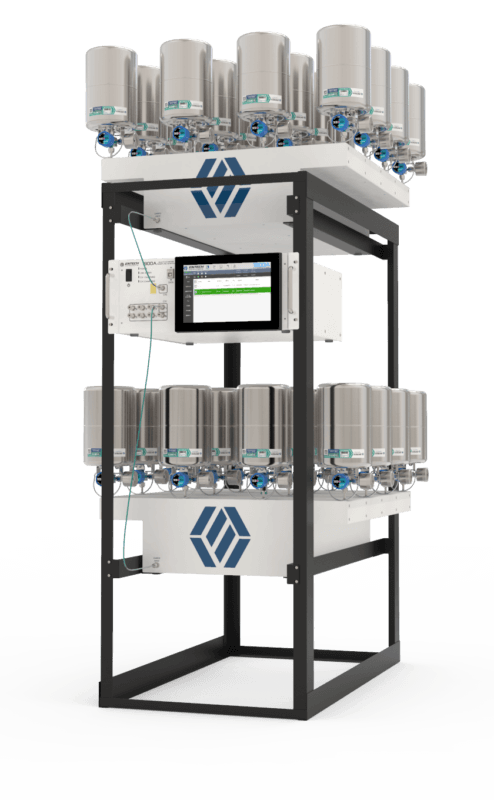
Two 1916As shown with Entech 2.5L Silonite Canisters.


